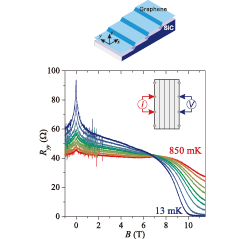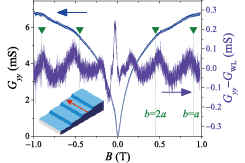Electrical Conduction in Epitaxial Graphene on Stepped Substrate of Vicinal SiC Surface
A. Endo, F. Komori, and S. Tanaka
Two-dimensional electron system (2DES) in graphene, i.e. a single or a few layers of graphitic sheet, has attracted much interest on account of its properties quite distinct from conventional 2DES. Graphene samples are typically produced either by “peel-and-stamp” technique or by epitaxial growth on appropriate substrates. In this study[1] monolayer graphene was grown on a vicinal surface of 6H-SiC(0001) which has a quasi-regular step-and-terrace structure as shown in Fig.1. This is analogous to 2DES in a GaAs/AlAs quantum well fabricated on the (775)B surface of GaAs [2].

Fig. 1. Epitaxial monolayer graphene grown on a vicinal surface of 6H-SiC(0001) which has a regular step-and-terrace structure. Resistance along the step exhibits negative magnetoresistance characteristic of weak localization at low field and well-developed quantum Hall effect (ν=2) at high field.

Fig. 2. Low field magnetoconductance with current along the steps exhibits oscillatory behavior superposed on the positive magnetoconduction attributable to the weak localization effect. The vertical dashed lines marked by arrows represent the expected positions of open orbit geometrical resonance.
Electrical conduction under a magnetic field normal to the plane showed a high degree of anisotropy. The quantum Hall effect (QHE) with zero resistance manifests itself for the current along the steps as shown in Fig.1, whereas the QHE is obscured by pronounced positive magnetoresistance with quadratic magnetic-field dependence for the current across the steps. The latter, as well as the small slope of the Hall resistance, implies the presence of parallel conduction due to remnant carriers in the SiC substrate, albeit with seeming inconsistency with the zero resistance observed for the former current direction. The anisotropic behavior is interpreted by assuming that the parallel conduction is sizable along the steps but is virtually prohibited across the steps
Conspicuous negative magnetoresistance in low field regime can be analysed by the weak localization formula. The phase relaxation time τø thus obtained is on the order of a few psec, which considerably exceeds the transport relaxation time τ~10-2 psec. The conductance along the steps is found to exhibit small-amplitude oscillations as shown in Fig. 2, after subtracting out the large positive magnetoconductance of the weak localization origin. This oscillatory behavior is attributed to open-orbit geometrical resonance effect previously elucidated in a GaAs/AlGaAs 2DES subjected to a unidirectional potential modulation [3].
References
- [1] A. Endo, F. Komori, K. Morita, T. Kajiwara, and S. Tanaka, J. Low Temp. Phys. 179, 237 (2015).
- [2] Y. Iye, A. Endo, S. Katsumoto, Y. Ohno, S. Shimomura, and S. Hiyamizu, Physica E 12, 200 (2002).
- [3] A. Endo and Y. Iye, Phys. Rev. B 71 081303(R) (2005).
